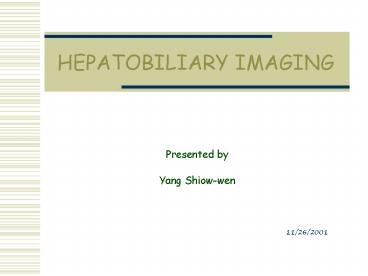HEPATOBILIARY IMAGING - PowerPoint PPT Presentation
1 / 30
Title:
HEPATOBILIARY IMAGING
Description:
Performed with a variety of compounds that share the common ... A magnification of two imminodiacetate compounds. Polar components chelated a Tc-99m molecule ... – PowerPoint PPT presentation
Number of Views:650
Avg rating:3.0/5.0
Title: HEPATOBILIARY IMAGING
1
HEPATOBILIARY IMAGING
- Presented by
- Yang Shiow-wen
- 11/26/2001
2
Hepatobiliary Imaging
- The function of the biliary tree and gall bladder
- A "HIDA" scan or a "DISIDA" scan
3
Hepatobiliary Imaging
- Performed with a variety of compounds that share
the common imminodiacetate moiety
4
Structures of DISIDA
- Blue color A polar component (the diacetate)
- Red A lipophilic component
5
Structures of DISIDA
- HIDA
- Little used today
- DISIDA
- Imaging the gall bladder better when liver
function is poor
6
Pathways of DISIDA
- The lipophilic component binding to hepatocyte
receptors for bilirubin - Transported through the same pathways as
bilirubin, except for conjugation
7
IDA-chelated Tc-99m
- A magnification of two imminodiacetate compounds
- Polar components chelated a Tc-99m molecule
8
Indications
- Acute cholecystitis
- Chronic cholecystitis
- Bile leakage
- Biliary atresia
9
Requirements for DISIDA Scan
- Patient preparation fasted for 4 hours
- Radiotracer Tc-99m IDA compounds i.v.
- Imaging serial anterior/lateral views for 60
minutes - Every 5 minutes for 30 minutes
- Once at 45 minutes
- Once at 1 hour
- Delayed views of the gall bladder 2 hours, 4
hours, 6 hours or 24 hours after injection
10
Requirements for DISIDA Scan
- Morphine
- Injection at one hour to help force the gall
bladder to fill - Water
- CCK
- Injection prior to the test to empty the gall
bladder - Suspected chronic cholecystitis
- Injection to measure how well the gall bladder
empties.
11
Normal Study
12
Acute Cholecystitis
- The most common indication
- S\S
- Nausea, vomiting, fever
- Right upper quadrant pain post-prandially
- Mild to moderate leukocytosis
- Abnormal liver function test
- Pain radiates to the back (scapula)
- Usually blockage of the cystic duct by a gallstone
13
Acute Cholecystitis
- If hepatic scintigraphy reveals adequate filling
of the gallbladder, acute cholecystitis is
effectively excluded. - Within 30 minutes, the gallbladder fails to
visualize - Wait for one whole hour
- Differential diagnosis for non-visualization of
the gallbladder - Relaxation of the sphincter of Oddi
- Inject morphine (3-5 milligrams) and continue the
study for another half an hour
14
Non-Visualization of Gallbladder
15
Non-Visualization of Gallbladder
Negative study after injection of morphine
16
Re-injected DISIDA Morphine
17
Chronic Cholecystitis
- Ultrasound is the primary modality of choice
- S\S
- Usually having gall stones
- The cystic duct is not blocked
- More chronic pain
- Delayed visualization of the gall bladder
- Biliary dyskinesia in response to administration
of CCK
18
Bile leaks
- Most appropriate non-invasive imaging technique
for evaluation of bile leaks - Sensitivity 87, Specificity 100 (2-3 ml of
labeled bile) - Radiopharmaceutical activity
- In an extrahepatic and extraluminal location
- More intense with time
- Differentiating intraluminal activity from a leak
- Ingestion of water
- Standing views in addition to anterior oblique
views
19
Reflux into Stomach
20
Radioactivity in Left Subphrenic Space-I
21
Bile Leak Post-cholecystectomy-II
22
No Excretion from Liver
- No excretion up to 6 hours
- This pattern is commonly seen in
- Ascending cholangitis
- Pancreatitis
- Hepatitis
23
Pseudo Gallbladder
Radionuclide in C-loop of the Duodenum
24
Pseudo Gallbladder
25
Pseudo Gallbladder
Disappear after ingestion of water
26
Obstruction at Ampulla
27
Irregular Uptake in Liver-I
28
Metastatic Deposits in Liver-II
29
References
- http//www.vh.org/Providers/Lectures/IROCH/Biliary
Nucs/BiliaryNucs.html (Virtual Hospital) - Chapter 38, Hepatobiliary Imaging, Darlene
Fink-Bennett, P759-770
30
The End
- Thank for Your Attention !































